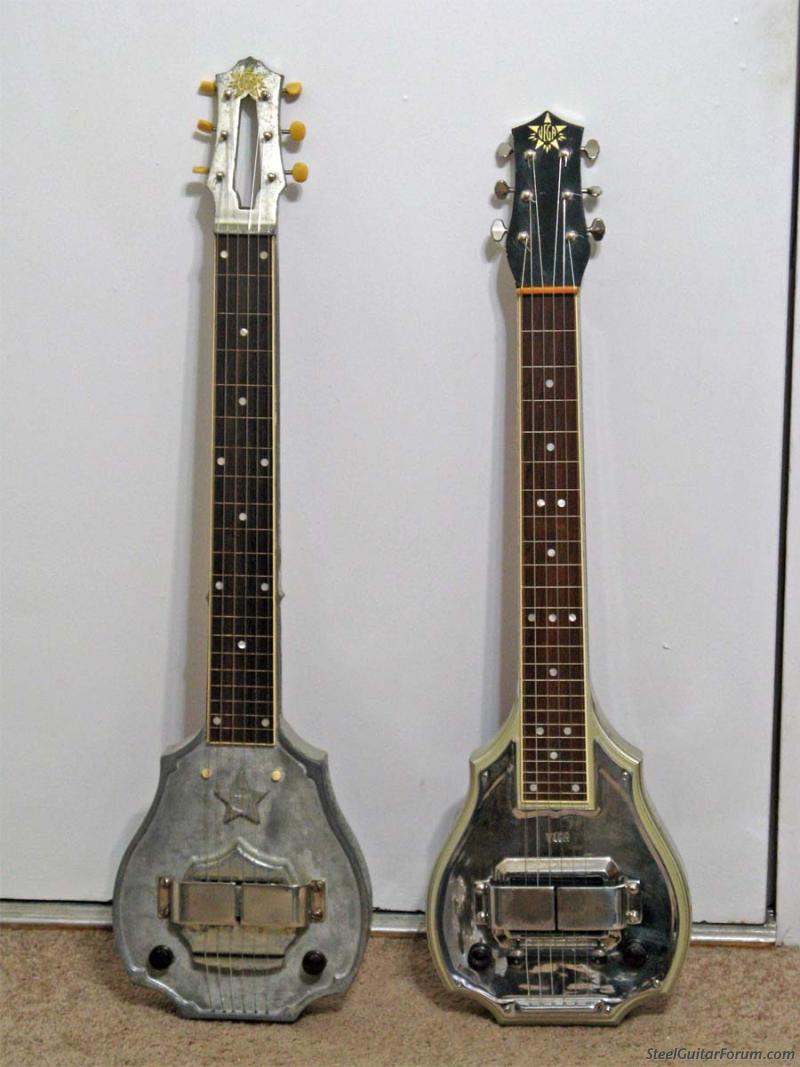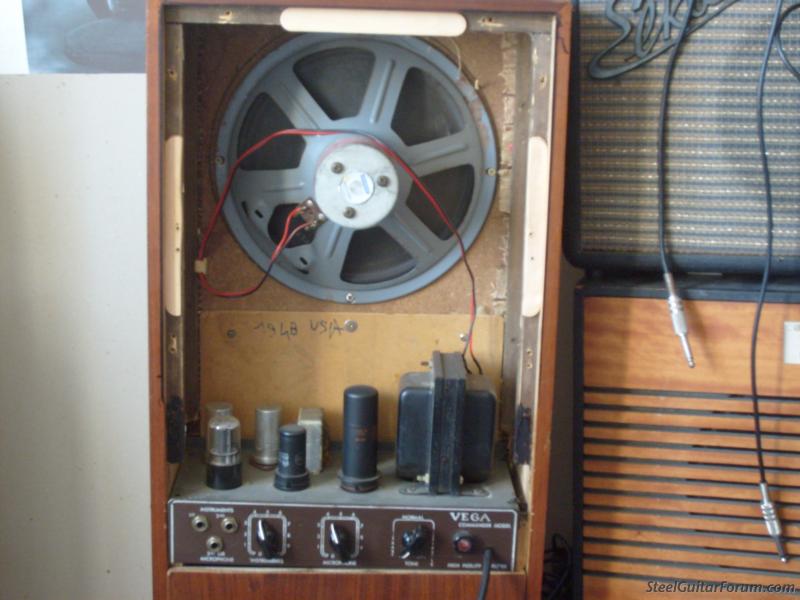| Author |
Topic: Two Vegas from the '30s |
Noah Miller
From:
Rocky Hill, CT
|
 Posted 23 Sep 2014 6:16 am
Posted 23 Sep 2014 6:16 am |
|
I'm something of a Vega buff, particularly where their early electric instruments are concerned. I've owned a few of their steels from the '30s through the '50s, so I was aware of how great they sound - especially those early ones with humbucking pickups. I couldn't resist when a rare cast-aluminum Vega showed up on Ebay, and then a slightly later wood-bodied companion appeared at the same time. They both arrived yesterday, and it's been a fun 24 hours.

While I used to have one identical to the wooden one on the right, I've never seen an aluminum Vega in person before. It turns out there are a few differences aside from the body material: the aluminum one has a 25" scale (vs 23" on the other one), and the pickup is subtly different. It appears to use the same coils and magnets, but the coils are separated by about 1/2" (with longer poles to make up the difference) and the entire pickup is further from the strings due to the thick cast top. The aluminum one therefore has lower output, but a more compressed sound. Its tone is also a bit mellower, but not extremely dark.
It took me a while to figure out what the white plugs were in the top of the cast body. After playing it for a while, I realized that they are 24th fret markers! Vega actually found a way to extend the fretboard beyond the frets. I think that Vega's main inspiration for the design was the National-Dobro aluminum steels. I say that partially because of the hole in the headstock, and partially because the board has a marker at the 20th fret instead of the 19th - just like many aluminum Nationals. I'll bet that the two-point body shape was taken from Vega's mandolins.
The wood-bodied steel sounds great as well. It sounds a bit brighter and has pretty hot output for a pre-War pickup. This would make a great rock and roll instrument. The sustain isn't as good as its older brother, but the brass top plate still lets it ring out for a while. |
|
|
 |
Don McGregor
From:
Memphis, Tennessee
|
 Posted 23 Sep 2014 6:57 am
Posted 23 Sep 2014 6:57 am |
|
| Beautiful. |
|
|
 |
Michael Greer
From:
Ontario, Canada
|
 Posted 23 Sep 2014 8:28 am
Posted 23 Sep 2014 8:28 am |
|
Hi Noah
I have a question for you about the Vega cast.
Is the cast model relatively heavy?
There was a cast Vega at the St Louis show that I had a look at and it weighed a TON....much heavier than a National cast steel. |
|
|
 |
Noah Miller
From:
Rocky Hill, CT
|
 Posted 23 Sep 2014 11:35 am
Posted 23 Sep 2014 11:35 am |
|
| The cast one weighs 9.5 lbs. As I recall, my National weighed something similar. The wood one is close, at 8.8 lbs. |
|
|
 |
Giandomenico Fioretto
From:
Italy
|
 Posted 21 Dec 2014 11:58 am
Posted 21 Dec 2014 11:58 am |
|
Salve Ho un fantastico VEGA Commander 1947 (not original case )



_________________
Hi, I come from Cagliari ,Italy, I m an Harmonica blues player ,but I play too dobro and resofonic guitars , , ! |
|
|
 |
Fred Kinbom
From:
Berlin, Germany, via Stockholm, Sweden.
|
|
|
 |
Craig McClure
From:
Jasper, N. Georgia, USA
|
 Posted 30 Aug 2024 5:24 am Another Pair of Early VEGAS
Posted 30 Aug 2024 5:24 am Another Pair of Early VEGAS |
|
I bought a Cast Aluminum VEGA from a scrap dealer - JUST the bare cast body - in very good condition. I don't know how it became stripped - either an interrupted restoration, or plan to sell the aluminum. IT was a stroke of luck for me - because I wanted an aluminum lap steel very much, & thought I'd never afford one. I've begun work on it, & have figured out plans to complete it.
Co-incidentally, I came across a wood bodied 1939 VEGA Model 100 a month earlier on Ebay, listed as "Untested/as-is condition" it had been relisted a couple of times & I got it for a low best offer (all I could spend) - After expressing to the seller haw big a gamble it was buying untested - with no emplacement parts available. It cleaned up very nice & actually works very well & sounds wonderful. Pleased & Grateful !

 |
|
|
 |




